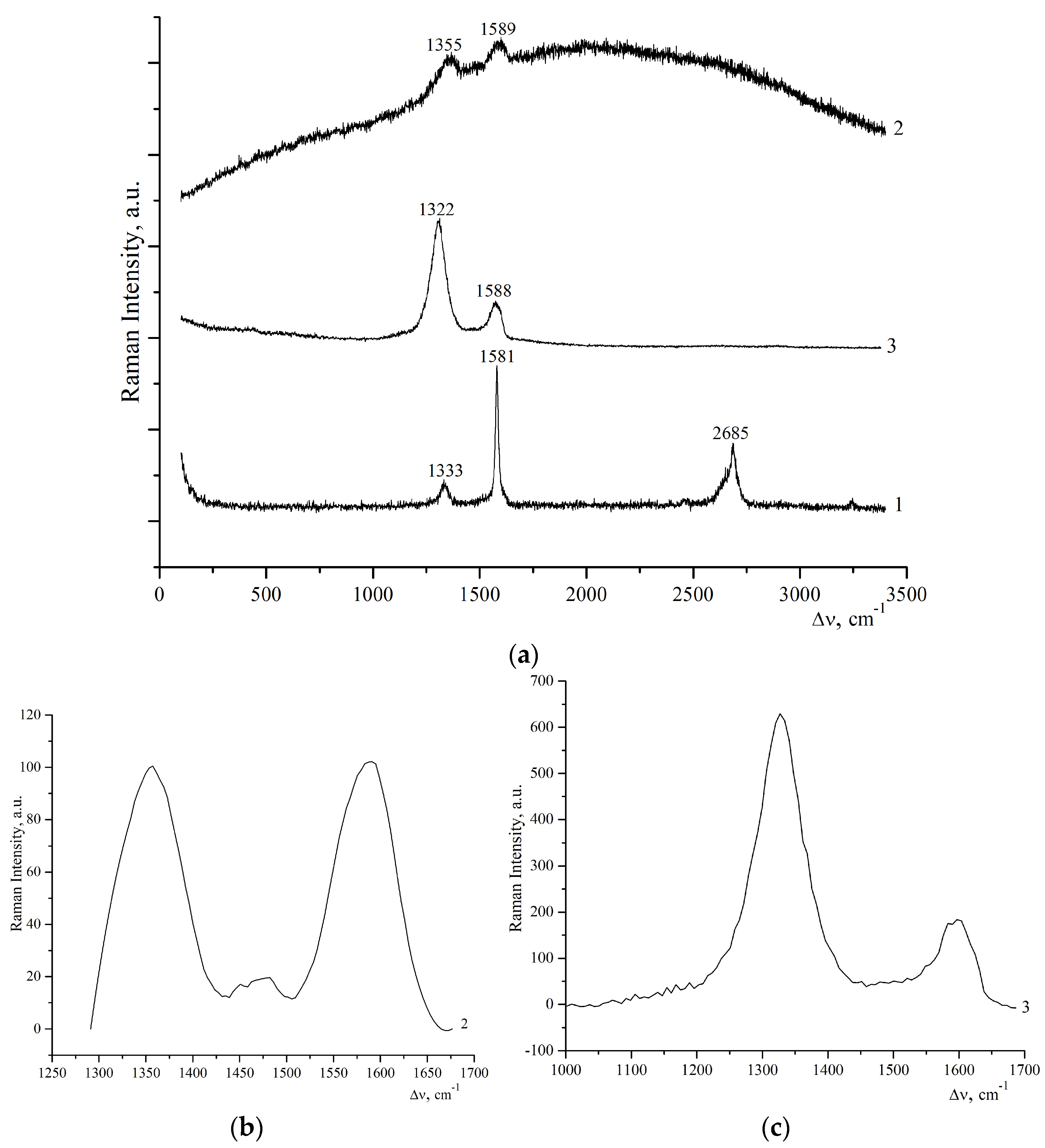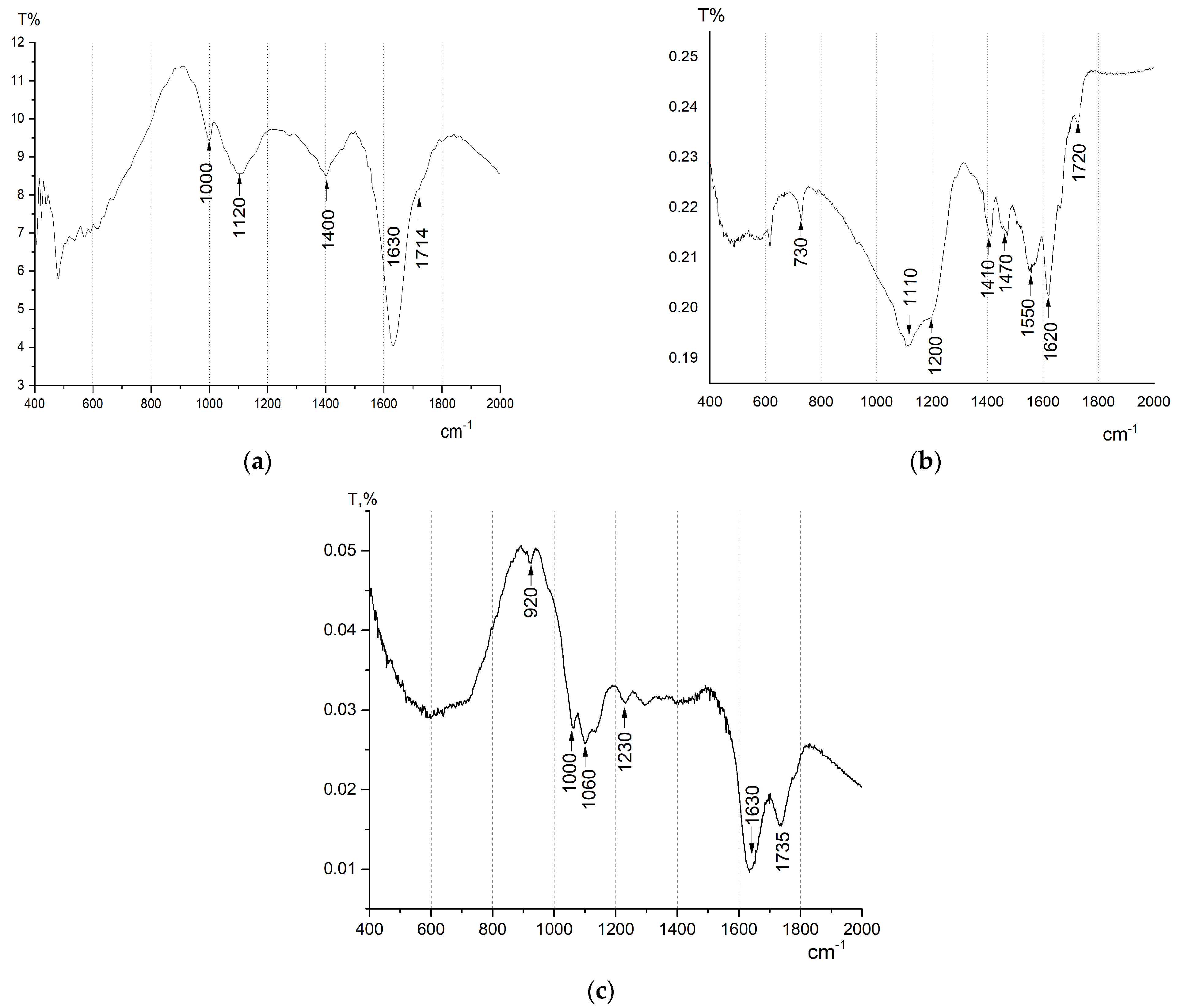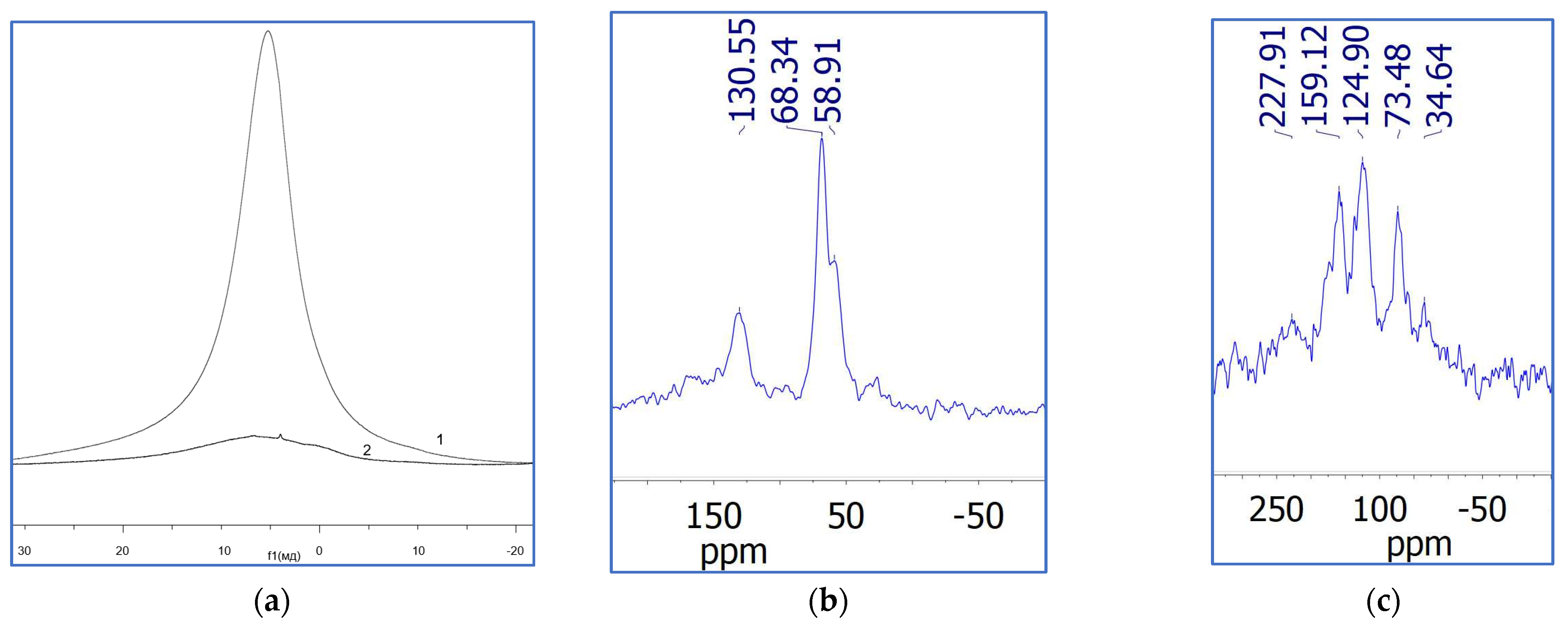Novel Insights into the Structure and Reduction of Graphene Oxide: A Case of Thiourea
Abstract
1. Introduction
2. Materials and Methods
2.1. Materials
2.2. Synthesis of Graphene Oxide (GO)
2.3. Reduction of Graphene Oxide
2.3.1. Reduction by Thiourea (rGO-TU)
2.3.2. Reduction by Ascorbic Acid (rGO-AA)
2.4. Preparation of Aerogels Using Sublimation Drying
2.5. Material Characterization
2.5.1. X-Ray Diffraction Phase Analysis (XRD)
2.5.2. Raman Spectroscopy
2.5.3. Transmission Electron Microscopy (TEM)
2.5.4. Scanning Electron Microscopy (SEM) with Energy Dispersive X-Ray Spectroscopy (SEM-EDS)
2.5.5. Fourier Transform Infrared Spectroscopy (FTIR)
2.5.6. Adsorption Experiment
2.5.7. Boehm Titration
2.5.8. Solid-State NMR
3. Results and Discussion
3.1. Morphology and Structure Characterization
3.2. Adsorption Properties
4. Conclusions
Author Contributions
Funding
Institutional Review Board Statement
Informed Consent Statement
Data Availability Statement
Conflicts of Interest
References
- Eltigani, H.H.; Boonyongmaneerat, Y. Progress of water desalination applications based on wettability and surface characteristics of graphene and graphene oxide: A review. J. Met. Mater. Miner. 2022, 32, 15–26. [Google Scholar] [CrossRef]
- Karimi-Nazarabad, M.; Goharshadi, E.K.; Mehrkhah, R.; Davardoostmanesh, M. Highly efficient clean water production: Reduced graphene oxide/graphitic carbon nitride/wood. Sep. Purif. Technol. 2021, 279, 119788. [Google Scholar] [CrossRef]
- Tiwary, S.K.; Singh, M.; Chavan, S.V.; Karim, A. Graphene oxide-based membranes for water desalination and purification. npj 2D Mater. Appl. 2024, 8, 27. [Google Scholar] [CrossRef]
- Cheng, S.-J.; Chiu, H.-Y.; Kumar, P.V.; Hsieh, K.Y.; Yang, J.-W.; Lin, Y.-R.; Shena, Y.-C.; Chen, G.-Y. Simultaneous drug delivery and cellular imaging using graphene oxide. Biomater. Sci. 2018, 6, 813–819. [Google Scholar] [CrossRef]
- Khatik, N.; Sachdeva, H. Graphite-based nanomaterials for drug delivery. Mater. Today Proc. 2022, 69, 30–35. [Google Scholar] [CrossRef]
- Rabchinskii, M.; Sysoev, V.; Ryzhkov, S.; Eliseyev, I.; Stolyarova, D.; Antonov, G.; Struchkov, N.; Brzhezinskaya, M.; Kirilenko, D.; Pavlov, S.; et al. Blueprint for the Synthesis and Characterization of Thiolated Graphene. Nanomaterials 2022, 12, 45. [Google Scholar] [CrossRef]
- Rabchinskii, M.K.; Sysoev, V.V.; Varezhnikov, A.S.; Solomatin, M.A.; Struchkov, N.S.; Stolyarova, D.Y.; Ryzhkov, S.A.; Antonov, G.A.; Gabrelian, V.S.; Cherviakova, P.D.; et al. Toward On-Chip Multisensor Arrays for Selective Methanol and Ethanol Detection at Room Temperature: Capitalizing the Graphene Carbonylation. ACS Appl. Mater. Interfaces 2023, 15, 28370–28386. [Google Scholar] [CrossRef]
- Feng, Y.; Wang, Z.; Zhang, R.; Lu, Y.; Huang, Y.; Shen, H.; Lv, X.; Liu, J. Anti-fouling graphene oxide-based nanocomposites membrane for oil-water emulsion separation. Water Sci. Technol. 2018, 77, 1179–1185. [Google Scholar] [CrossRef]
- Lancellotti, L.; Sansone, L.; Bobeico, E.; Lago, E.; Della Noce, M.; Delli Veneri, P.; Borriello, A.; Casalino, M.; Coppola, G.; Giordano, M.; et al. Graphene oxide as an interfacial layer in silicon based Schottky barrier solar cells. In Proceedings of the 17th Italian Conference on Photonics Technologies, Fotonica AEIT, Turin, Italy, 6–8 May 2015. [Google Scholar] [CrossRef]
- Chi, C.H.; Hsu, Y.C.; Tseng, L.C.; Suen, S.Y.; Wu, J.Y.; Lee, R.H. Carbon nanotube and graphite oxide surfaces modified with polyethylene oxide for dye-sensitized solar cells. J. Polym. Res. 2013, 20, 269. [Google Scholar] [CrossRef]
- Dissanayake, M.A.K.L.; Kumari, J.M.K.W.; Senadeera, G.K.R.; Jaseetharan, T.; Weerasinghe, J.; Anwar, H. A low-cost, vein graphite/tin oxide nanoparticles based composite counter electrode for efficient dye-sensitized solar cells. Mater. Sci. Eng. B 2021, 273, 115440. [Google Scholar] [CrossRef]
- Zięba, W.; Jurkiewicz, K.; Burian, A.; Pawlyta, M.; Boncel, S.; Szymański, G.S.; Kubacki, J.; Kowalczyk, P.; Krukiewicz, K.; Furuse, A.; et al. High-Surface-Area Graphene Oxide for Next-Generation Energy Storage Applications. ACS Appl. Nano Mater. 2022, 5, 18448–18461. [Google Scholar] [CrossRef]
- Razaq, A.; Bibi, F.; Zheng, X.; Papadakis, R.; Jafri, S.H.M.; Li, H. Review on graphene-, graphene oxide-, reduced graphene oxide-based flexible composites: From fabrication to applications. Materials 2022, 15, 1012. [Google Scholar] [CrossRef]
- Ma, X.-Q.; Shan, Y.-Q.; Wang, M.-Y.; Alothman, Z.; Xu, Z.; Duan, P.; Zhou, J.; Luque, R. Mechanochemical Preparation of N,S-Doped Graphene Oxide Using (NH4)2SO4 for Supercapacitor Applications. ACS Sustain. Chem. Eng. 2020, 8, 18810–18815. [Google Scholar] [CrossRef]
- Liu, T. Overlooking Issues and Prospective Resolutions Behind the Prosperity of Three-Dimensional Porous Carbon Supercapacitor Electrodes. Front. Energy Res. 2020, 8, 125. [Google Scholar] [CrossRef]
- Bernal-Ortega, P.; Bernal, M.M.; Blume, A.; González-Jiménez, A.; Posadas, P.; Navarro, R.; Valentín, J.L. Sulfur-Modified Carbon Nanotubes for the Development of Advanced Elastomeric Materials. Polymers 2021, 13, 821. [Google Scholar] [CrossRef]
- Li, Y.; Wei, Z.; Sun, Z.; Zhai, H.; Li, S.; Chen, W. Sulfur modified carbon-based single-atom catalysts for electrocatalytic reactions. Small 2024, 20, 2401900. [Google Scholar] [CrossRef] [PubMed]
- Lu, Z.; Chen, Y.; Liu, Z.; Li, A.; Sun, D.; Zhuo, K. Nitrogen and sulfur co-doped graphene aerogel for high performance supercapacitors. RSC Adv. 2018, 8, 18966–18971. [Google Scholar] [CrossRef]
- Pang, K.; Sun, W.; Ye, F.; Yang, L.; Pu, M.; Yang, C.; Zhang, Q.; Niu, J. Sulfur-modified chitosan derived N,S-co-doped carbon as a bifunctional material for adsorption and catalytic degradation sulfamethoxazole by persulfate. J. Hazard. Mater. 2022, 424, 127270. [Google Scholar] [CrossRef]
- Zhao, C.X.; Yuan, C.G.; Duan, X.L.; Guo, Q.; Shen, Y.W.; Ma, X.P.; Xie, J.J.; Zhang, K.G. Fabrication of sulfur-based functionalized activated carbon as solid phase extraction adsorbent for selective analysis of selenite in water. J. Hazard. Mater. 2024, 479, 135685. [Google Scholar] [CrossRef] [PubMed]
- Wu, J.; Qiu, X.; Chen, S. Preparation and characterization of an amine-modified graphene aerogel for enhanced carbon dioxide adsorption. J. Mater. Sci. 2022, 57, 1727–1737. [Google Scholar] [CrossRef]
- Wang, X.; Yi, S.; Guo, H.; Li, C.; Ding, S. Erosion characteristics of electrical discharge machining using graphene powder in deionized water as dielectric. Int. J. Adv. Manuf. Technol. 2020, 108, 357–368. [Google Scholar] [CrossRef]
- Świercz, R.; Oniszczuk-Świercz, D. The Effects of Reduced Graphene Oxide Flakes in the Dielectric on Electrical Discharge Machining. Nanomaterials 2019, 9, 335. [Google Scholar] [CrossRef]
- Behera, A.; Sahoo, A.K.; Mahapatra, S.S. Experimental investigation of plain and nano-graphene oxide mixed dielectric for sustainable EDM of Nimonic alloy using Cu and Brass electrode: A comparative study. Measurement 2025, 241, 115659. [Google Scholar] [CrossRef]
- Gudkov, M.V.; Stolyarova, D.Y.; Shiyanova, K.A.; Melnikov, V.P. Polymer composites with graphene and its derivatives as functional materials of the future. Polym. Sci. Ser. C 2022, 64, 40–61. [Google Scholar] [CrossRef]
- Alemasova, N.V.; Sukhova, S.R.; Stepkina, D.I.; Burkhovetskii, V.V.; Savos’kin, M.V. Formation of Three-Dimensional Structures by Graphite Oxide of Different Nature in the Interaction with Thiourea. Inorg. Mater. Appl. Res. 2023, 14, 81–85. [Google Scholar] [CrossRef]
- Liu, Y.; Li, Y.; Yang, Y.; Wen, Y.; Wang, M. Reduction of Graphene Oxide by Thiourea. J. Nanosci. Nanotechnol. 2011, 11, 10082–10086. [Google Scholar] [CrossRef]
- Chen, Y.-J.; Chung, A.; Hsi, H.-C. Selective adsorption of gold ion in wastewater with competing cations by novel thiourea-reduced graphene oxide. Sustain. Environ. Res. 2024, 34, 21. [Google Scholar] [CrossRef]
- Yang, J.; Gong, D.; Li, G.; Zeng, G.; Wang, Q.; Zhang, Y.; Liu, G.; Wu, P.; Vovk, E.; Peng, Z.; et al. Self-Assembly of Thiourea-Crosslinked Graphene Oxide Framework Membranes toward Separation of Small Molecules. Adv. Mater. 2018, 30, 1705775. [Google Scholar] [CrossRef]
- Naser, A.A.; Al-Sawaad, H.Z.; Al-Mubarak, A.S. Novel graphene oxide functionalization by urea and thiourea, and their applications as anticorrosive agents for carbon steel alloy in acidic medium. J. Mater. Environ. Sci. 2020, 11, 404–420. [Google Scholar]
- Cançado, L.G.; Takai, K.; Enoki, T.; Endo, M.; Kim, Y.A.; Mizusaki, H.; Jorio, A.; Coelho, L.N.; Magalhães-Paniago, R.; Pimenta, M.A. General equation for the determination of the crystallite size of nanographite by Raman spectroscopy. Appl. Phys. Lett. 2006, 88, 163106. [Google Scholar] [CrossRef]
- ISO 9001:2015; Quality Management Systems—Requirements. International Organization for Standardization (ISO): Geneva, Switzerland, 2015.
- Jiao, X.; Qiu, Y.; Zhang, L.; Zhang, X. Comparison of the characteristic properties of reduced graphene oxides synthesized from natural graphites with different graphitization degrees. RSC Adv. 2017, 7, 52337–52344. [Google Scholar] [CrossRef]
- Brzhezinskaya, M.; Kapitanova, O.O.; Kononenko, O.V.; Koveshnikov, S.; Korepanov, V.; Roshchupkin, D. Large-scalable graphene oxide films with resistive switching for non-volatile memory applications. J. Alloys Compd. 2020, 849, 156699. [Google Scholar] [CrossRef]
- Zhao, W.; Tan, P.H.; Liu, J.; Ferrari, A.C. Intercalation of few-layer graphite flakes with FeCl3: Raman determination of Fermi level, layer by layer decoupling, and stability. J. Am. Chem. Soc. 2011, 133, 5941–5946. [Google Scholar] [CrossRef]
- Xue, B.; Zhu, J.; Liu, N.; Li, Y. Facile functionalization of graphene oxide with ethylenediamine as a solid base catalyst for Knoevenagel condensation reaction. Catal. Commun. 2015, 64, 105. [Google Scholar] [CrossRef]
- Brusko, V.; Khannanov, A.; Rakhmatullin, A.; Dimiev, A.M. Unraveling the infrared spectrum of graphene oxide. Carbon 2024, 229, 119507. [Google Scholar] [CrossRef]
- Vrettos, K.; Karouta, N.; Loginos, P.; Donthula, S.; Gournis, D.; Georgakilas, V. The Role of Diamines in the Formation of Graphene Aerogels. Front. Mater. 2018, 5, 20. [Google Scholar] [CrossRef]
- Gonçalves, M.G.; Costa, V.O.; Martinez, A.H.G.; Régnier, B.M.; Gomes, G.C.B.; Zarbin, A.J.G.; Orth, E.S. Functionalization of graphene oxide via epoxide groups: A comprehensive review. Front. Carbon. 2024, 3, 1393077. [Google Scholar] [CrossRef]
- Shnitov, V.; Rabchinskii, M.; Brzhezinskaya, M.; Stolyarova, D.; Pavlov, S.; Baidakova, M.; Shvidchenko, A.; Kislenko, V.; Kislenko, S.; Brunkov, P. Valence Band Structure Engineering in Graphene Derivatives. Small 2021, 17, 2104316. [Google Scholar] [CrossRef] [PubMed]
- Lu, N.; Huang, Y.; Li, H.; Li, Z.; Yang, J. First principles nuclear magnetic resonance signatures of graphene oxide. J. Chem. Phys. 2010, 133, 034502. [Google Scholar] [CrossRef]
- Caliman, C.C.; Mesquita, A.F.; Cipriano, D.F.; Freitas, C.C.; Cotta, A.C. One-pot synthesis of amine-functionalized graphene oxide by microwave-assisted reactions: An outstanding alternative for supporting materials in supercapacitors. RSC Adv. 2018, 8, 6136–6145. [Google Scholar] [CrossRef]
- Vacchi, I.A.; Spinato, C.; Raya, J.; Bianco, A.; Ménard-Moyon, C. Chemical reactivity of graphene oxide towards amines elucidated by solid-state NMR. Nanoscale 2016, 8, 13714–13721. [Google Scholar] [CrossRef]
- Lee, D.W.; Seo, J.W. Formation of Phenol Groups in Hydrated Graphite Oxide. J. Phys. Chem. C 2011, 115, 12483–12486. [Google Scholar] [CrossRef]
- Borik, R.M.; Fawzy, N.M.; Abu-Bakr, S.M.; Aly, M.S. Design, Synthesis, Anticancer Evaluation and Docking Studies of Novel Heterocyclic Derivatives Obtained via Reactions Involving Curcumin. Molecules 2018, 23, 1398. [Google Scholar] [CrossRef] [PubMed]
- Bencivenni, L.; Cesaro, S.; Pieretti, A. Matrix and ab initio infrared spectra of thiourea and thiourea-d4. Vib. Spectrosc. 1998, 18, 91–102. [Google Scholar] [CrossRef]
- Ma, Q.; Wang, W.; Ge, W.; Xia, L.; Song, S. Synthesis of a Composite Aerogel of Reduced Graphene Oxide Supported by Two-Dimensional Montmorillonite Nanolayers for Methylene Blue Removal. Clays Clay Miner. 2021, 69, 746–758. [Google Scholar] [CrossRef]









| Sample | (002) Diffraction Peak | ||||
|---|---|---|---|---|---|
| 2θ, ° | FWHM, ° | H, nm | d, nm | n | |
| Graphite | 26.60 | 0.32 | 26.66 | 0.34 | 78–79 |
| GO | 11.41 | 0.61 | 13.50 | 0.80 | 16–17 |
| rGO-TU | 23.24 | 5.58 | 1.52 | 0.38 | 4 |
| rGO-AA | 19.68 | 5.52 | 1.53 | 0.45 | 3–4 |
| Sample | Frequency, cm−1 | Intensity (I) | FWHM | ID/IG | La, nm | |||
|---|---|---|---|---|---|---|---|---|
| Band D | Band G | Band D | Band G | Band D | Band G | |||
| Graphite | 1333 | 1586 | 106 | 731 | 39.97 | 14.99 | 0.15 | 265.44 |
| GO | 1355 | 1589 | 101 | 101 | 80.75 | 76.39 | 1.00 | 38.48 |
| rGO-TU | 1322 | 1588 | 629 | 201 | 82.89 | 64.68 | 3.13 | 12.99 |
| Sample | Total Acidic Groups, mmol/g | Carboxyl | Lactone | Phenol |
|---|---|---|---|---|
| GO | 1.90 | 0.10 | 1.42 | 0.38 |
| rGO-TU | 0.41 | - | 0.39 | 0.02 |
| rGO-AA | 2.15 | 0.42 | 1.15 | 0.58 |
| Element | Percentage of the Element, % | ||
|---|---|---|---|
| GO | rGO-TU Aerogel | rGO-AA Aerogel | |
| S Ka | 1.6 ± 0.0 | 6.49 ± 1.75 | 0.12 ± 0.03 |
| O Ka | 38.3 ± 0.2 | 24.73 ± 3.25 | 33.26 ± 1.91 |
| N Ka | - | 21.94 ± 5.60 | - |
| C Ka | 59.8 ± 0.2 | 46.84 ± 8.33 | 66.62 ± 1.88 |
| Cl Ka | 0.3 ± 0.0 | - | - |
| Parameter | rGO-TU Aerogel | rGO-AA Aerogel | ||
|---|---|---|---|---|
| in 5 min | in 1440 min | in 5 min | in 1440 min | |
| Cin, mg/L | 4.26 | 2.92 | 4.08 | 1.09 |
| X, mg/g | 53.47 | 60.20 | 56.01 | 71.41 |
Disclaimer/Publisher’s Note: The statements, opinions and data contained in all publications are solely those of the individual author(s) and contributor(s) and not of MDPI and/or the editor(s). MDPI and/or the editor(s) disclaim responsibility for any injury to people or property resulting from any ideas, methods, instructions or products referred to in the content. |
© 2025 by the authors. Licensee MDPI, Basel, Switzerland. This article is an open access article distributed under the terms and conditions of the Creative Commons Attribution (CC BY) license (https://creativecommons.org/licenses/by/4.0/).
Share and Cite
Oskolkova, O.; Gnatovskaya, V.; Trush, D.; Vylivok, E.; Khomutova, E.; Fershtat, L.; Larin, A. Novel Insights into the Structure and Reduction of Graphene Oxide: A Case of Thiourea. Materials 2025, 18, 5135. https://doi.org/10.3390/ma18225135
Oskolkova O, Gnatovskaya V, Trush D, Vylivok E, Khomutova E, Fershtat L, Larin A. Novel Insights into the Structure and Reduction of Graphene Oxide: A Case of Thiourea. Materials. 2025; 18(22):5135. https://doi.org/10.3390/ma18225135
Chicago/Turabian StyleOskolkova, Oksana, Viktoriya Gnatovskaya, Darya Trush, Elena Vylivok, Ekaterina Khomutova, Leonid Fershtat, and Alexander Larin. 2025. "Novel Insights into the Structure and Reduction of Graphene Oxide: A Case of Thiourea" Materials 18, no. 22: 5135. https://doi.org/10.3390/ma18225135
APA StyleOskolkova, O., Gnatovskaya, V., Trush, D., Vylivok, E., Khomutova, E., Fershtat, L., & Larin, A. (2025). Novel Insights into the Structure and Reduction of Graphene Oxide: A Case of Thiourea. Materials, 18(22), 5135. https://doi.org/10.3390/ma18225135







